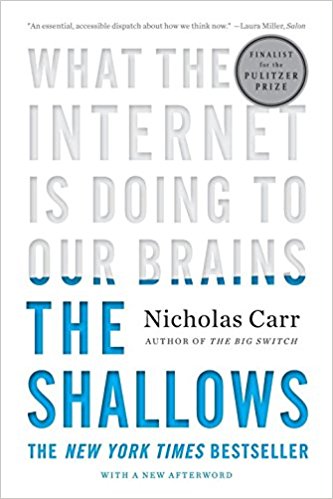“The force field of deep time”: Birkerts’s The Gutenberg Elegies turns 25
Monday, February 18th, 2019Sven Birkerts‘s The Gutenberg Elegies: The Fate of Reading in an Electronic Age, turns 25 this year. Never heard of it? A sign of our times, when everything goes blip, blip, blip under the tumultuous seas of tweets, texts, posts, and emoticons. Even a book that ponders what we need most today to fight the tide of memes, spammers, taunts, and triviality: “time of the self… deep time, duration time, time that is essentially characterized by our obliviousness to it.”
You may not have read Mairead Small Staid’s thoughtful consideration of Birkerts’s fifteen essays “on reading, the self, the convergence of the two, and the ways both are threatened by the encroachment of modern technology” over at Paris Review‘s blog. After all, few things disappear faster under the surface of public consciousness than a blogpost – like this one.
Staid writes: “As the culture around him underwent the sea change of the internet’s arrival, Birkerts feared that qualities long safeguarded and elevated by print were in danger of erosion: among them privacy, the valuation of individual consciousness, and an awareness of history—not merely the facts of it, but a sense of its continuity, of our place among the centuries and cosmos. ‘Literature holds meaning not as a content that can be abstracted and summarized, but as experience,’ he wrote. ‘It is a participatory arena. Through the process of reading we slip out of our customary time orientation, marked by distractedness and superficiality, into the realm of duration.’”
Two excerpts:
Early in The Gutenberg Elegies, Birkerts summarizes historian Rolf Engelsing’s definition of reading “intensively” as the common practice of most readers before the nineteenth century, when books, which were scarce and expensive, were often read aloud and many times over. As reading materials—not just books, but newspapers, magazines, and ephemera—proliferated, more recent centuries saw the rise of reading “extensively”: we read these materials once, often quickly, and move on. Birkerts coins his own terms: the deep, devotional practice of “vertical” reading has been supplanted by “horizontal” reading, skimming along the surface. This shift has only accelerated dizzyingly in the time since Engelsing wrote in 1974, since Birkerts wrote in 1994, and since I wrote, yesterday, the paragraph above.
Horizontal reading rules the day. What I do when I look at Twitter is less akin to reading a book than to the encounter I have with a recipe’s instructions or the fine print of a receipt: I’m taking in information, not enlightenment. It’s a way to pass the time, not to live in it. Reading—real reading, the kind Birkerts makes his impassioned case for—draws on our vertical sensibility, however latent, and “where it does not assume depth, it creates it.”
***
“But perhaps when the need is strong enough we will seek out the word on the page, and the work that puts us back into the force field of deep time,” says Birkerts. “The book—and my optimism, you may sense, is not unwavering—will be seen as a haven, as a way of going off-line and into a space sanctified by subjectivity.” Oddly enough, here in the dawning days of 2019, my own optimism is strong. It seems clear to me that the need is strong enough—is as strong as it always has been and always will be—for the blossoming, bodily pleasure of reading something remarkable, the way it takes the top of my head off and shows me—palms open, an offering—what’s been churning away in there, all along.
“Resonance—there is no wisdom without it,” Birkerts writes. “Resonance is a natural phenomenon, the shadow of import alongside the body of fact, and it cannot flourish except in deep time.” But time feels especially shallow these days, as the wave of one horror barely crests before it’s devoured by the next, as every morning’s shocking headline is old news by the afternoon. Weeks go by, and we might see friends only through the funhouse mirrors of Snapchat and Instagram and their so-called stories, designed to disappear. Not even the pretense of permanence remains: we refresh and refresh every tab, and are not sated. What are we waiting for? What are we hoping to find?
We know perfectly well—we remember, even if dimly, the inward state that satisfies more than our itching, clicking fingers—and we know it isn’t here. Here, on the internet, is a nowhere space, a shallow time. It is a flat and impenetrable surface. But with a book, we dive in; we are sucked in; we are immersed, body and soul. “We hold in our hands a way to cut against the momentum of the times,” Birkerts assures. “We can resist the skimming tendency and delve; we can restore, if only for a time, the vanishing assumption of coherence. The beauty of the vertical engagement is that it does not have to argue for itself. It is self-contained, a fulfillment.”
Read the whole essay here. Or better yet, by the whole book here. I will, too … when I have time. I’m on deadline. Oddly enough, I am finishing an essay about … the social media.





 Years ago, when I wrote the introduction to
Years ago, when I wrote the introduction to The Internet and social media have trained my brain to read a paragraph or two, and then start looking around. When I read an online article from the Atlantic or the New Yorker, after a few paragraphs I glance over at the slide bar to judge the article’s length. My mind strays, and I find myself clicking on the sidebars and the underlined links. Soon I’m over at CNN.com reading Donald Trump’s latest tweets and details of the latest terrorist attack, or perhaps checking tomorrow’s weather.
The Internet and social media have trained my brain to read a paragraph or two, and then start looking around. When I read an online article from the Atlantic or the New Yorker, after a few paragraphs I glance over at the slide bar to judge the article’s length. My mind strays, and I find myself clicking on the sidebars and the underlined links. Soon I’m over at CNN.com reading Donald Trump’s latest tweets and details of the latest terrorist attack, or perhaps checking tomorrow’s weather.









